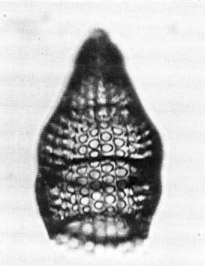 Eucyrtidium
matuyamai Hays
Eucyrtidium
matuyamai Hays Eucyrtidium
matuyamai Hays
Eucyrtidium
matuyamai HaysEucyrtidium matuyamai Hays, 1970, p.213, pl.1, figs.7-9
Cephalis spherical to hemispherical bearing short thorn-like apical spine. Pores either absent or very small scattered over surface. Thorax usually inflated, heavy with rough surface, pores circular arranged in longitudinal rows bordered by raised hexagonal frames. Lumbar stricture distinct. Abdomen conical, pores circular regularly increasing in size distally, arranged in longitudinal rows set in shallow furrows. Fourth segment usually inflated, shell has greatest width at this segment, pores circular of uniform size arranged in longitudinal rows set in shallow furrows. Fifth segment tapering distally, pores circular arranged in longitudinal rows set in shallow furrows decreasing in size distally. Sixth segment short, usually terminal segment in complete specimens, thinner than other segments, pores irregular in size and arrangement (Hays, 1970).
Measurements made on mature specimens near the end of the range of the species. Length of cephalis 15-23 µm, of thorax 17-30 µm, of 3rd segment 35-50 µm, of 4th segment 36-68 µm, of 5th segment 30-70 µm, of 6th segment 23-60 µm. Width of cephalis 20-35 µm, of 4th segment 118-150 µm (near end of range), 72-110 (near beginning of range). Length of apical horn 3-6 µm. Diameter of pores, thorax 2-6 µm, 3rd segment 3-9 µm, 4th segment 6-12 µm, 5th segment 6-12 µm, 6th segment 3-12 µm (Hays, 1970).
See E. calvertense and E. inflatum.
E. matuyamai ranges from near the base of the Olduvai event (about 2 m.y. B.P.) to the base of the Jaramillo event (about 0.95 m.y. B.P.). During this time it increases in size reaching its maximum dimensions near the end of its range. This species ranged from the Bering Sea to 34°N. It has not been seen in either equatorial Pacific sediments or Antarctic sediments.
The evolutionary transition of this species from E. calvertense defines the base of the middle-latitude Eucyrtidium matuyamai Zone. Its morphotypic last appearance defines the top of the same zone.
E. matuyamai evolved from E. calvertense between about 2 Ma and 1.6 Ma in subarctic waters and subsequently invaded subtropical waters. It became extinct about 0.9 Ma. Details of this evolutionary sequence can be found in Hays (1970).